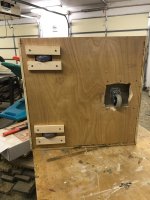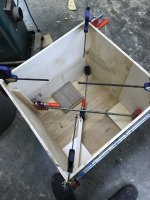It is that way but since it's plywood I'm not sure how much difference it makes.
Let me try explain my thinking (which might be totally wrong).
We need to accept that end grain gluing has, to all intents and purposes, no strength.
Imagine, for the sake of the discussion, that you make up your own ply, consisting of two boards. The bottom board is Ash and the grain runs east-west. On top of that, you glue a board of Oak with its grain running north-south.
Rip the ply in half, along the grain of the Oak.
If you were to glue those two halves back together again without changing any orientation, the Oak will be glued long-grain to long-grain (lots of strength), and the Ash end-grain to end-grain (no strength). The joint has 50% glue strength.
If you were to glue those two halves back together again but this time rotating one board 90 degrees, the Oak will be glued long-grain to end-grain (no strength), and the Ash end-grain to long-grain (no strength). The joint has zero glue strength.
Ken


